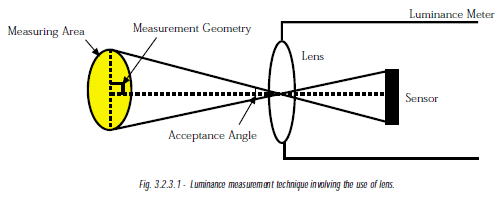Language of Light
3.Instrumentation
3.2 PHOTOMETER
3.2.3 APPLICATIONS OF PHOTOMETERS
There are a multitude of Light Measurement to be made. Not surprisingly, misapplication of photometric instrument by user can become a common source of error. For many users, the main obstacle to effective light measurement is the lack of understanding of the characteristics of the type of measurement required. Attempts to convert between units will lead to gross errors. For example, the most common mistake encountered is attempting to use illuminance meter (lumen/m2) to determine luminuos flux (lumen), or, to use luminance meter (candela/m2) to determine the luminous intensity (candela).
There are four main photometric instruments, namely the luminance meter, illuminance meter, luminous flux meter, and luminous intensity meter.
3.2.3.1 LUMINANCE METER
The visible energy output of a light source can be determined with a luminance measurement. Luminance is a directional quantity and, hence, we have to specify the acceptance angle of the instrument, measured area, and measurement geometry with respect to the source, in order to communicate the luminance measurements effectively. These factors are important as most light sources are not perfect lambertian sources (luminance is the same in all direction) and might not be uniform in luminance throughout the sources.
Since measurement is targeted at the source, such measurement can be achieved by using a optical lens system. Both the angular field of view and the angle subtended by the objective lens should be limited to avoid collecting light from parts of the display at slightly different angles.

Luminance measurement are important for products, such as traffic lights, televisions, and tail lights of automobiles.

